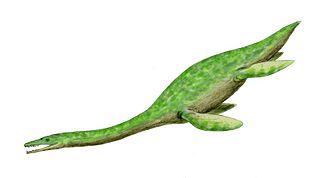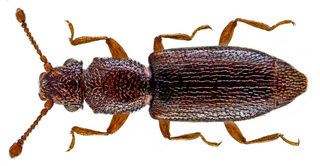
The eastern long-necked turtle is an east Australian species of snake-necked turtle that inhabits a wide variety of water bodies and is an opportunistic feeder. It is a side-necked turtle (Pleurodire), meaning that it bends its head sideways into its shell rather than pulling it directly back.

Thililua is a genus of polycotylid plesiosaur, containing one species, T. longicollis. The name Thililua is derived from that of an ancient aquatic god from local Berber mythology; longicollis refers to the animal's long neck. Thililua has been found in Late Cretaceous rocks in the High Atlas mountains of Morocco in north Africa. Thililua is the first Polycotylid plesiosaur discovered in Africa, and also the first discovered that lived at a subtropical latitude. In 2010, Thililua was transferred to Leptocleididae as a sister taxon to Nichollssaura.

Acalolepta australis is a species of flat-faced longhorns beetle belonging to the family Cerambycidae, subfamily Lamiinae.

Acalolepta is a genus of flat-faced longhorns beetle belonging to the family Cerambycidae, subfamily Lamiinae. Its members are found in the Indomalayan realm.
Acalolepta griseofasciata is a species of beetle in the family Cerambycidae. It was described by Stephan von Breuning in 1935, originally under the genus Dihammus. It is known from Papua New Guinea, Vanuatu, and the Solomon Islands.
Acalolepta itzingeri is a species of beetle in the family Cerambycidae. It was described by Stephan von Breuning in 1935.
Acalolepta sikkimensis is a species of beetle in the family Cerambycidae. It was described by Stephan von Breuning in 1935.
Acalolepta magnetica is a species of beetle in the family Cerambycidae. It was described by Francis Polkinghorne Pascoe in 1866, originally under the genus Monochamus. It is known from Micronesia, Moluccas and Indonesia.
Acalolepta permutans is a species of beetle in the family Cerambycidae. It was described by Francis Polkinghorne Pascoe in 1857, originally under the genus Monohammus. It is known from Japan, Vietnam, Taiwan, and China. It feeds on Albizia julibrissin.
Acalolepta antenor is a species of beetle in the family Cerambycidae. It was described by Newman in 1842. The typical form is known from the Philippines, but numerous subspecies are widespread in Indonesia, Moluccas, Micronesia, New Guinea, Australia, Solomon Islands and Samoa.
Acalolepta fraudatrix is a species of beetle in the family Cerambycidae. It was described by Henry Walter Bates in 1873. It is known from Korea, Japan, China, and Russia.
Acalolepta mixta is a species of beetle in the family Cerambycidae. It was described by Frederick William Hope in 1841, originally under the genus Monohammus. It is known from Australia, and was introduced to the Solomon Islands, Indonesia, Singapore and Vietnam. It feeds on Theobroma cacao, Adansonia digitata, Mangifera indica, Excoecaria agallocha, and Moringa oleifera.
Acalolepta rusticatrix is a species of beetle in the family Cerambycidae. It was described by Johan Christian Fabricius in 1801, originally under the genus Lamia. It is known from Myanmar, India, the Philippines, Malaysia, Sumatra, Sri Lanka, Java, Taiwan, Indonesia, Sulawesi, and Vietnam.
Acalolepta sejuncta is a species of beetle in the family Cerambycidae. It was described by Henry Walter Bates in 1873. It is known from Japan.
Acalolepta sublusca is a species of beetle in the family Cerambycidae. It was described by James Thomson in 1857, originally under the genus Monochamus. It is known from Malaysia, China, Singapore, Japan, Laos, Taiwan, Cambodia, and Vietnam.
Cardiocephaloides longicollis is a species of flukes. The life cycle of C. longicollis is asexual as well as complex. Its asexual stage resides in the body of whelks where it replicates many times, and eventually its eggs are dispersed in the water through feces. C.longicollis begin their early life as free swimming miracidia larvae in the water. They go on to infect snails, and a variety of fishes, usually second intermediate host, in the form of a cercariae. While C.longicollis has previously been recorded in 19 fish species, researchers have found 12 other species which are viable hosts for C.longicollis making for a grand total of 31 aquatic species. The final host for this parasite are the gulls that eat the infected fish in which the parasite has formed cysts in.
Charybdis longicollis, the lesser swimming crab, is a species of crab from the swimming crab family, the Portunidae. It has a native range which covers the north-western Indian Ocean and it has been invaded the Mediterranean Sea by Lessepsian migration through the Suez Canal.

Monotoma longicollis is a species of root-eating beetle in the family Monotomidae. It is found in Africa, Australia, Europe & Northern Asia, North America, and Southern Asia.
Coleorozena longicollis is a species of case-bearing leaf beetle in the family Chrysomelidae. It has one subspecies. It is found in North America.



